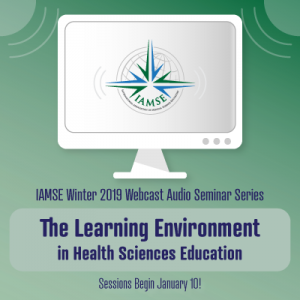
[The following notes were generated by Will Brooks, PhD.]
IAMSE Webinar Series, Winter 2019
Speakers: Larry Gruppen, PhD
Title: An Overview and Introduction to the Learning Environment
Series: The Learning Environment in Health Sciences Education
The IAMSE 2019 Winter Webinar Series, The Learning Environment in Health Sciences Education, kicked off to a strong start on January 10, 2019 with a presentation by Dr. Larry Gruppen, Professor in the Department of Learning Health Sciences at the University of Michigan Medical School. His webinar entitled “An Overview and Introduction to the Learning Environment” provided a framework on the topic upon with other speakers in the series will build in the coming weeks.
Dr. Guppen began with an acknowledgment of the recent scoping review of literature on the learning environment for the Josiah Macy Foundation in 2018 from which much of the webinar would be based. He noted that the learning environment and associated concepts are defined variably by individuals and that theories and measurements surrounding the topic have not yet been fully established. The AMA defines the learning environment as a social system that includes the learner (including the external relationships and other factors affecting the learner), the individuals with whom the learner interacts, the setting and purposes of the interaction, and the formal and informal rules/policies/norms governing the interaction (AMA, 2007). However, a modified definition was put forth by the Josiah Macy Conference in 2018: the social interactions, organizational culture and structures, and physical and virtual spaces that surround and shape the learners’ experiences, perceptions, and learning.
A challenge faced by those exploring the learning environment is that virtually anything could be considered a part of it including physical facilities, faculty, the patient population, curriculum, institutional culture, assessments, clinical settings, etc. As Dr. Gruppen stated, “If everything is part of the learning environment, then effectively nothing is part of the learning environment.” Another challenge lies in the absence of a common language; educational climate, social environment, and work environment are all synonyms in common use. Dr. Gruppen contrasted the hidden curriculum from the learning environment as separate entities, though some literature may equate the two.
As the root word environ means ‘to surround’, the learning environment can be considered those factors which surround learning. Five dimensions of the learning environment grouped into three domains were defined by Dr. Gruppen: in the Sociocultural Domain, (1) person, (2) social, and (3) organization; within the Spatial Domain, (4) the physical environment; and in the Technology Domain, (5) the virtual learning spaces.
Differences within the person such as personality, resilience, and life experiences all influence how one learns and thus affect the learning environment. Interactions between the learner and his/her peers, faculty, patients, and interprofessional colleagues all impact the social dimension of the learning environment. The organizational level is often blamed for toxic learning environments due to factors including work load, stress, etc. Physical spaces including classrooms, meeting rooms, and their furnishings in addition to critical general features such as new versus old facilities and the proximity of spaces all comprise the spatial domain. Virtual patients, electronic health records, online learning, and technology driven simulation affect the virtual dimension of the learning environment.
A variety of instruments have been utilized to measure the learning environment, but all depend upon self-reporting of the learner through survey questionnaires. As such, data collected to date have been dependent on learner perspectives.
Dr. Gruppen completed the webinar with a discussion of ideas currently circulating in health professions education and in the literature on how to fix the learning environment. The first discussed was curricular change. A publication was discussed which detailed the effects on the learning environment of a comprehensive curricular change that included transition to an organ system-based structure with pass/fail grading. This intervention yielded a moderate to large effect size on the learning environment, but it cannot be possible to pinpoint which factors were most important for the improvement, underscoring the complexity of the issue. Secondly, a Dutch study that examined key factors predicting work engagement among faculty was discussed. This study highlights the fact that faculty engagement and faculty satisfaction impact the learning environment. Faculty are both contributors to and recipients of the learning environment. Faculty development is thus an important cog to consider when thinking about improving the learning environment. Finally, Dr. Gruppen noted that much of the literature on the learning environment centers on student experiences and mistreatment.
While the learning environment is a complex and still poorly defined topic, its importance in medical and health professions education cannot be understated. It is critical for issues related to stress, burn-out, and suicide; it impacts productivity and patient care; and failures in the learning environment can have punitive financial consequences for an organization.